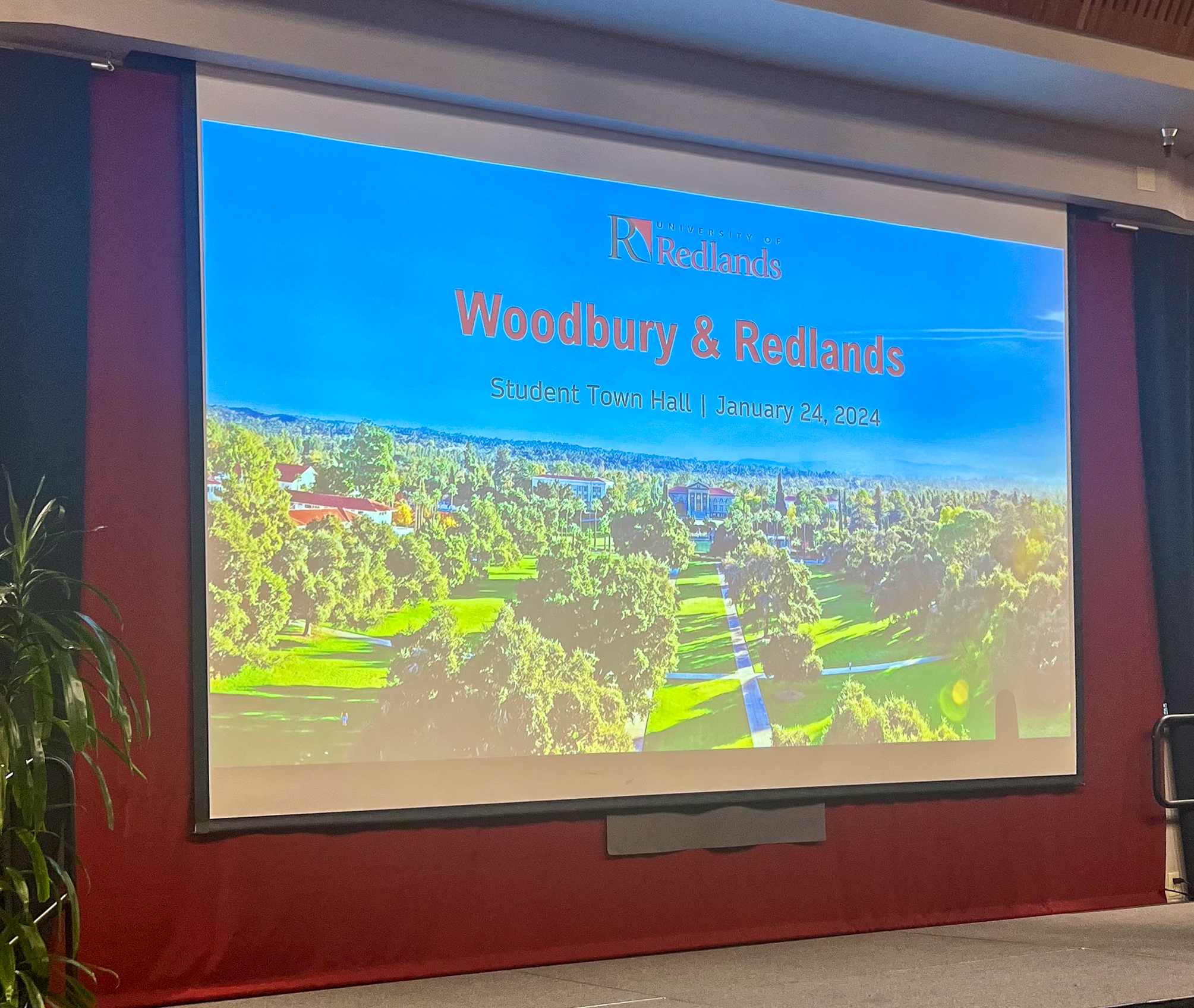
Opinions are diverse on the integration of Woodbury University into the University of Redlands, but the merger is set to proceed as planned. Speaking to the audience at the town hall on Jan. 24, University President Krista Newkirk gave a detailed explanation of the rationale behind this decision and answered key questions about what the merger would mean for students.
Also in attendance at the town hall was the Dean of College of Arts and Sciences Justin Rose, Vice President for Finance Kevin Dyerly, Associate Provost for Faculty & Academic Innovation Anne Cavender, and others. Meanwhile, Sharon Townsend, Senior Director of Development and Alumni Affairs, represented Woodbury University.
Firstly, Why Seek A Merger At All?
According to Newkirk, it’s about improving the student experience, expanding opportunities, and increasing the value of a University of Redlands degree.
“So, when we look at a merger we really think about some of the necessary elements, like are they aligned with our mission? Do we have good cultural alignment?” Newkirk said.
Unlike for-profit mergers, Newkirk explained, those between non-profit institutions are not driven by a need to make money but rather to save on money by operating more efficiently and taking advantage of economies of scale, which in this case could benefit students by making tuition more affordable.
“This is really a realization that two institutions, when they come together, can complement each other,” Newkirk said.
But Why Woodbury University?
The greatest strength of Woodbury University lies in their art-related programs. According to the presentation, Woodbury is most known for their Architecture degree with the highest number of students in the university enrolling in its School of Architecture. Top majors also include Graphic Design, Interior Design and Game Design, where 323 of Woodbury’s students are enrolled in the School of Media, Culture and Design. In addition, the university is located near major film studios, which creates valuable career and internship opportunities in the entertainment industry for its students.
These opportunities, not the location, are the main attraction for Redlands students, Newkirk said. Out of the 97 responses to the student survey sent out on Jan. 11, 84% said they are supportive of the merger and believe the HSI and AAPI Serving status is a bonus. The Woodbury major most anticipated by Redlands students is Interior Design.
A comparison between Woodbury University and the University of Redlands reveals other key similarities, as well as differences.
| Woodbury | Redlands | |
| Non-profit | Yes | Yes |
| Fully accredited | Yes | Yes |
| Total student body | 898 | 3,222 |
| Student to faculty ratio | 8:1 | 13:1 |
| Percentage of students receiving financial aid | 96% | 93% |
| Asian American and Native American Pacific Islander-Serving Institution | Yes | No |
| Hispanic-Serving Institution | Yes | Yes |
| Undergraduate and graduate major | 30 | 70+ |
| Student organizations | 30+ | 100+ |
| Year founded | 1884 | 1907 |
| Residential Halls | 2 | 12 |
| Graduation requirement | Internship program | Volunteer program |
| Athletics | No | Yes |
Is It All Just Smooth-Sailing From Here?
Not quite, according to Newkirk. From this point in time, until Woodbury University officially becomes part of the University of Redlands, many long and complicated procedures must be completed. In particular, the Department of Education must sign off on the merger and approve that the process does not harm any students. This is the part of the journey that will take the most time, “probably 12 months or longer,” Newkirk said.
Of course, there are internal challenges that would need to be sorted out. The question of curriculum is a notably important one. On one hand, Woodbury’s General Education requirements are different from Redlands’, while on the other hand, there are overlapping programs that would be integrated together. Newkirk discussed a possible solution to this problem, “we might have some of our faculty teaching there or vice versa,” but additional concerns arose in the Q&A portion of the town hall.
Responding to a student’s question on whether there would be layoffs, Newkirk explained that she couldn’t ensure there wouldn’t be any layoffs, but because the overlap between programs are small, it is hoped the layoffs would be minimal. Sharon Townsend, the representative from Woodbury, also added that any such layoff would be handled in the most “respectful and humane” way possible.
However, for the majority of faculty members at Redlands the challenges revolve around changes to the teaching modality and changes in curricula – a conversation that continues to be the point of contention in the merger process. According to Newkirk, the result from the faculty survey was “about 50-50” in support of the merger.
A forthcoming story on The Redlands Bulldog will take a deeper dive into the complicated ways this change both affects and presents opportunities for faculty.
On the students’ side, care would be taken to ensure students’ experience remains uninterrupted; whether that be in terms of degree requirement or tuition, Newkirk said. The exact details of how that goal would be accomplished is a work-in-progress among faculty and staff members.
Though they are still in the rough draft stage, some possible plans include:
- Providing additional financial aid to Woodbury students if the tuition needed to increase to match Redlands’,
- Having a “3+2” program where students would come to Redlands for the Gen Ed requirements then transfer to Woodbury for their specific majors,
- Or even making the Woodbury campus a May Term option.
“That creates a new opportunity for students that may not be considering either Woodbury or Redlands today, and might be attracted to that opportunity,” added Kevin Dyerly, vice president for Finance.
What About Finances?
Madison Escoto, the only student besides the Redlands Bulldog news staff to attend the in-person town hall (others joined via Zoom), questioned whether this endeavor would take away the resources needed to improve accessibility on campus.
Newkirk answered, “We’ve taken on a lot of debt to improve accessibility […] [The merger] is a way to improve the financial situation of both campuses.”
This is in reference to Woodbury University’s need for additional financial support. Currently, Woodbury has “about $22 million in bond debt at a very low interest rate of 2.89%”, Newkirk said, adding that this is a “reasonable cost” that Redlands can handle.
Another concern raised by Escoto was the comparison of the Woodbury-Redlands merger to other mergers among higher education institutions. The controversial acquisition of Mills College by Northeastern University highlights the possibility of what Escoto calls “academic colonization” and the “erasure” of the smaller campus.
The difference between the Mills-Northeastern case and Woodbury-Redlands is the fact the former is done to acquire real estate, while the driving force for Redlands is the “great alignment in programs and values,” Newkirk said. Furthermore, too much of Mills College’s programs overlapped with Northeastern, which is not the case here. Comparing between the two mergers would be like “talking apples and oranges, in a sense,” according to CAS Dean Justin Rose.
Dyerly added, “Eighty percent of the academic programs at Woodbury are complementary and additive to Redlands’ programs.”
Speaking to the Redlands Bulldog afterwards, Escoto explained her concern with the merger comes from her own experience of being a Mills College student when Northeastern University acquisition occurred. She talked of disruptive changes to housing, health insurance plans, staff layoffs, and security measures. Though Escoto acknowledged that the Woodbury-Redlands situation is different from Mills-Northeastern, the answers given by university administration at the town hall did not seem definitive and concrete enough for her in terms of how they would be able to protect the interests of Woodbury students.
“I mainly wanted to go there and make sure that the administration knew that there was at least one person watching them,” Escoto said. “I wanted to ensure that the Woodbury students wouldn’t be subjected to the same repression that [Northeastern University] put on us [Mills students]. I think the University of Redlands should be careful to make sure they don’t become Northeastern University.”
Escoto also expressed her wish for more students to pay attention to this matter. “I think we should all be very interested in looking very closely at this merger, even if it doesn’t affect us. We should still be looking out for our academic peers.”
As part of her mobilizing efforts, Escoto has submitted an essay on the Mills-Northeastern merger for the Social Justice Conference hosted by the department of Women & Gender Studies in late March and encourages students to attend the conference.
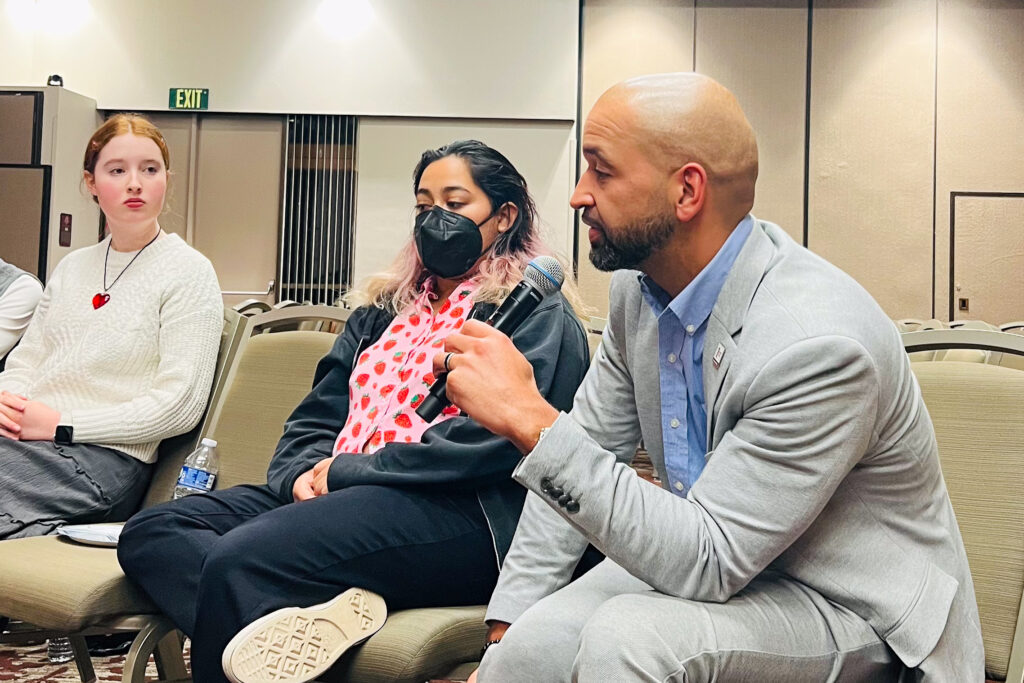
Where Do We Go From Here?
In ten years, the aspiration for the merger is to recombine efforts, establish brand recognition, and see “what we can build by bringing faculty together,” Newkirk said. What this means remains unclear. The three-campus vision with Redlands at the center and the Marin and Woodbury campuses being offered alongside online programs is a concrete visualization of the university’s future.
“It’s not just what we accomplish, but also how we go about it,” Newkirk concluded.
Woodbury University is not the only higher education institution joining the University of Redlands within just the past year. In June 2023, proceedings began for the merger of Presidio Graduate School into Redlands’ School of Business and Society to form the Presidio Center for Sustainable Solutions at the Marin Campus. In Aug. 2023, Redlands’ School of Performing Arts added the Kodály Center at the Holy Names University into its list of music programs. Earlier in 2019, the San Francisco Theological Seminary became a part of Redlands’ graduate degree offerings.
Photos by Anika Tabassum.
Quynh Nguyen is a senior and double majoring in Economics and International Relations. She has written for the Redlands Bulldog since 2019 and she believes in the importance of journalism for a dynamic community like the U of R. In her free time, Quynh enjoys reading and playing Wordle.

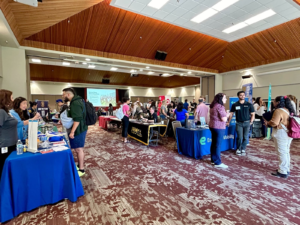
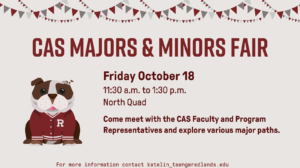
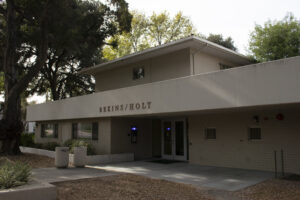
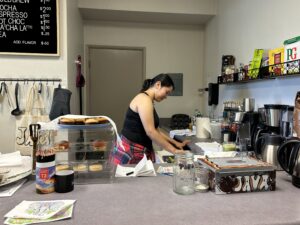
Thank you for your insightful reporting. I am one of the 6 intital Woodbury faculty who received layoff notices on Feb 14 and 15. Especially grateful to Redlands University student Madison Escoto reminding everyone that amidst all the financial numbers and curriculum strategies there is a very real human cost to this potential acquisition that is already permeating throughout Woodbury University. Your article revealed new information and will provide additional insight for the entire Woodbury Community. Keep up the good work Redlands Bulldog!!
Regards,
Patrick Nickell
Associate Professor School of MCD
Coordinator Design Foundation
Director Nan Rae Gallery
Guggenheim Fellow 2014 Fine Arts
Patrick.nickell@woodbury.edu